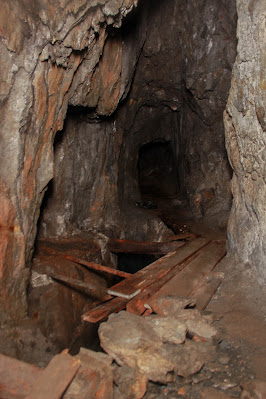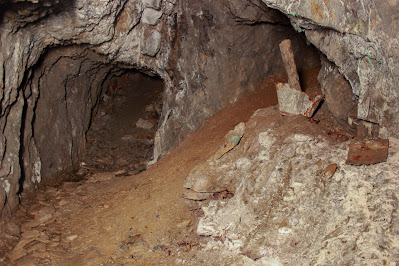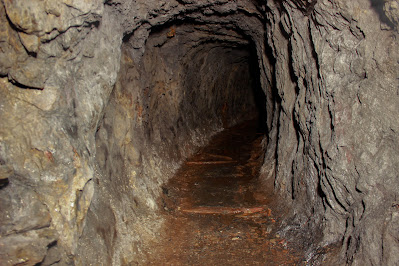A little while ago, I joined Niall and his friend Carly to check out a mine that I'd wanted to do for some time. The mine had first come onto my radar when someone had posted it on a Facebook group with some comments along the lines of "Ooooooh only three people know about this mine. It's our little secret."
I kinda feel like the person might have been lied to by whoever tipped him off, because the mine is nobodys secret, and thousands of people know about it. Whoopsie. The surface ruins are open to the public and the area is a popular dog walking spot. There's even stairs leading up to a capped mine shaft where people can stand on the metal grate and gaze down into the depths.
But to actually get down there, people need to have a bit more of a mooch. But once we found it, it was all fairly straight forward.
Slipping inside was pretty easy. The entire entry passage is flooded but that wasn't a problem. We explored this in the midst of a heat wave, and being somewhere underground and shin-deep in water was actually quite refreshing. However the contrast was such that upon emerging from the mine at the end of the adventure, it felt like my legs were on fire, soaking wet and freezing as they were, suddenly exposed to the heat once again. I did a bit of a comedic dance out there.
Following its closure in 1900, the mine itself was abandoned and dormant, save for some scrap theft in 1910 when the bearings of the titular water wheel were removed. It wasn't until 1971, over half a century later, that a chap heard a rumour from a former miner that there was a huge underground water wheel somewhere in the area. He went out to see if there was any truth behind such a story, and discovered this tunnel.
The passage drys up before opening into a reasonably larger chamber, where we found the wheel in question.
Isn't this cool??? What my pictures don't convey is the size of the thing. It's about five metres in diameter. That's quite large. You could lie two of me in a line across the circumference of that, and still have space left over for about three Alices.
Imagine being the chap who discovered this in 1971, hearing a rumour and wading deep into the unpredictable and dangerous underground only to find that it was true, and that this thing had been sat down here for a hundred years. He must have felt so amazed.
And just think, it would have had to have been constructed down here, with the workers operating under candle light. That's pretty impressive.
While some say that this water wheel is unique in its survival, one more does exist in an abandoned mine in Cumbria. The two are said to be the only water wheels currently accessible in abandoned mines, which is a rather hopeful description that highlights their rarity while also saying "Maybe there's more still out there."
It was in 1870 that a chap called Adam Mason leased the land for the purpose of mining copper, silver, lead and zinc. And he must have been pretty damn confident he'd get results too, because he put about £3000 into equipping the mine with modern machinery. According to a calculator on the bank of Englands website, that's about £250,000 by todays standards.
Initially only able to get the mine about twelve fathoms deep in 1871, it was the installation of this water wheel operating a drainage pump that allowed additional depth, eventually peaking at four levels over some fifty fathoms. That's about 300 feet.
This is the winding and pumping shaft from which the water wheel pumped out any flood water from the tunnels below. As you can see, it's been a while since it was put to use. The shaft is now flooded, and the water itself is no doubt contiminated by rust and minerals from its surroundings. I did see a video online of someone placing an underwater drone in here. It went down for quite some time before eventually coming to some old trackbed, still preserved with the rails on it, unlike the trackbed in the dry areas. That's the part about abandoned mines that intrigues me the most. There's so much more that we don't see.
Still, it is possible to see where the tracks used to be. These horizontal lines are where the wooden sleepers used to sit.
While Adam Mason was ambitious and certainly thought this area could fetch him some dosh, he had not been the first to take a interest here. The mining of precious metals was taking place here as far back as 1700, although initial work dried up and the mines were abandoned in 1760. In 1853, two guys, Charles Kirkpatrick and T A Readwin, took an interest in the place. A little research shows that these two had their fingers in a lot of pies when it came to mines. Numerous documents alude to legal squabbles between them and other mine owners over who owns what. However they abandoned this one within a year.
Two brothers started working here but even they gave up on it in 1869.
So one has to wonder what Adam Mason was thinking. After a string of failed attempts to mine this place for metal, why did he think he was going to fare any better? Sure, he probably thought that throwing his money around like STDs at a house party in Telford might give him better chances of reaching the stuff that everyone else had missed, but even he must have realised that the expenditure was a massive gamble.
Another notable feature of the mine is this wooden walkway over a massive flooded drop. It's only a matter of time before the wood rots and the pathway plunges into the water below. But I was determined to cross it, and Niall was also determined to cross it. Carly needed some persuading, but she wasn't about to stay on the boring side of the bridge by herself, so she was in.
Excellent. It's nice when we're all on the same page.
Just a shame it's the last page of a book called "We're going to die."
As you can see, we made it. In all seriousness, if I was to fall, I can swim so it wouldn't be a massive drop. Success would depend on whether I whacked my head on the way down, or if help could be reached before I froze to death. But the fall itself? That would be a doddle.
Up
on the surface there was quite a sexy factory. Water was the main source of
power, so a nifty series of wooden
troughs re-routed it to the factory from the river.
Far
different from the tranquil countryside of today, it would have been a hive of activity, with the constant sound of machinery. It must have been quite the sight to
behold back in its glory days. Unfortunately the glory days were short
lived.
Rocks
were pulled out of the mine shaft and placed into storage bins. Water
was poured through these to remove mud from the rocks, which were
then sorted through to see if any contained the precious metals. Records from 1891 show that this job was carried out by a thirteen year old
and an eighteen year old boy while the men worked down below.
From
there, water wheels powered the stone breaker and crushing machine that
broke the rocks down into manageable chunks, eventually to
the consistency of gravel. From there a machine called a jigger, also
powered by a water wheel, separated the waste rock from the metal.
Then
there was another water-powered thingie called the Bundle which went
over even the waste rock for trace amounts of anything valuable so that
absolutely nothing would go to waste. Even waste water from the rock-washing
process went through the bundles just to make sure nothing had been
accidentally caught up in that. The waste water was then purified of any
poisons it might have obtained, before being fed back into the river.
This part of the tunnel has had a bit of collapse, but it's still possible to slip through this hole and continue the journey.
There's another area where the flood water continues, and one has to scramble over a pile of rubble in order to continue.
The top of the rubble pile looking down into the water.
And for the sake of scale, here's Niall and Carly sat on the rubble pile. None of us were wearing protective equipment, which I'm just going to say for the sake of a mini disclaimer, is a health & safety no-no. Mines are probably one of the most dangerous things anyone can explore. Bits of the ceiling can fall. Sometimes the floor is false. Often they build walkways over shafts like we saw back there. They aren't to be taken lightly. There's no signal here. If anything bad happens, you're pretty fucked.
So we're setting a terrible example.
I mean, I don't take my own mortality too seriously and neither should you. My existence is ridiculous. But anyone else should probably at least wear a helmet and gloves.
When I'm adventuring, I always try to put myself in the shoes of the people who a location mattered to, and the mine is no different. This isn't just a random cave. This is a workplace. And while modern camera technology lets us
see the details, people would have been working down here in near
total darkness. Just imagine the length of your shift at work, and imagine it spent down here. It's pretty incredible.
Records from 1891 show that only nine men worked down here, but by then morale must have been low. Much to Adam Masons disappointment, the mine was described as spectacularly unprofitable.
In 1883 a report from the mine read "No ore sold this quarter." Later on in 1885, they reported "We have not made any returns whatsover during the last year."
So it seemed the money pit had dried up. People were working all day, and carts of rock were whizzing along these tunnels for the goods to be hauled up to the surface, containing absolutely nothing profitable. It must have been soul draining for those who spent their working day down here and not seeing any results.
In 1891, records show that they produced some five tons of silver and lead, worth about £37, ten tons of zinc worth about £15, and five tons of copper worth about £7. By todays standards that totals at about £5000, which doesn't sound so bad. I'm sure quite a few of us would be happy to sell £5000 worth of silver. But consider that as a years work from a business perspective. It's not brilliant. It's certainly not sustainable.
A report from 1897 reported nine tons of lead, ten tons of zinc and 45 tons of copper, but it was still pretty low, and the mine closed around 1900. Eager to make some money out of the place, most of the machinery was sold. The mine was abandoned.
Once the area had renewed interest, plans were made in the 1980s to
remove the water wheel for a museum, but it was decided instead to
preserve it and make the area safe. The whole area was landscaped, and the main shaft was capped in 1993 to stop people falling in, but also to allow people to stand over it and gaze down into the depths. As for the tunnel, that was gated off, but curiously not locked.
Either it was but someone broke the lock, or a level of trust has been placed in the general public to use common sense. That's a bold move.
There's a bit of machinery on the floor here.
Finally we emerged at the bottom of the engine shaft. Over a hundred years ago, workers would have hauled the rocks up here to be retrieved by those working on the surface.
Now water is pouring down constantly, meaning I was getting pretty wet taking these pictures, and as you can see, there's a grate on the top so it is possible to smile and wave at tourists. Apparently this is about eighty feet to the surface.
The water gathers at the bottom. Records show that this shaft is actually 300 feet deep, and here we are just eighty feet from the surface. So clearly the shaft is blocked. I did some checking online and apparently it's not known if the blockage fills right down to the bottom of the shaft or not.
It would have been nice to have known that before I went wading out into it. Yikes!
So that's it for me, but disapointingly, I later learned that about ten feet up the shaft from here, accessible via the rope just visible in the background, there is another tunnel that goes on for a bit. It still has the rails attached to the ground, so I'm a little miffed that I missed it. It also apparently has another wooden board over a shaft, this one invisible due to the flood water exceeding the hole amd covering the floor. That sounds exciting!
But alas, we missed it.
To summarise, as far as mines go this one is perfect for beginners. Anyone can just stroll on in, providing they have suitable footwear or dont mind getting their feet wet. The main attraction, the water wheel, is fairly close to the entrance, so some of the more daring aspects of the mine aren't necessary if you just want to see that chunk of history. I do advise wearing some sort of head protection if you are going to come into a mine though.
As for the surrounding area, it's beautiful and great for wild swimming, dog walking and hiking. Even if you're the cowardly one in your friend group, you can wait outside the mine and still have a great day with your friends once they've checked it out.
That's it for me! My next two blogs will also be mines, but they're each unique in their own little way, and there's a gradual incline in risk, and a decline in my common sense, just when you thought I couldn't get any stupider. In the meantime, social media is an algorithmic hellscape and if you like the blog and want to see more, then can get updates on my Instagram, my Vero, my Reddit, and the ones I don't like, Facebook and Twatter.
Thanks for reading!





























A trust in the public to use common sense? Oh come on.
ReplyDelete